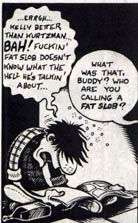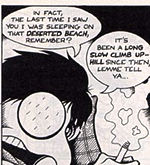>> The Friday Review: Pubo
>> The Friday Review: Get Your War On
More...

 Writer/Artist: Peter Bagge
Writer/Artist: Peter Bagge
Collecting HATE #1-5
Price: $11.95
Publisher: Fantagraphics
ISBN: 1560971134
Cast your mind back ten years. A US-led military coalition has just bombed the shit out of some shifty-looking Middle Eastern country, consumer confidence in the west has reached an all time low, and the American economy is firmly in the grip of recession. (I'm sure that anyone too young to remember all this will have no trouble visualising it). The college-educated youth of America respond to this turn of events by becoming all alienated and angsty, embracing en masse the counterculture lifestyle that had been quietly flourishing throughout the eighties in places like Atlanta, Boston and Seattle.
This trend does not go unnoticed in the halls of corporate power (where it's evidently decided that "if you can't beat 'em, join 'em"), and America's flannel-clad 'alternative' culture is suddenly vaulted into the harsh glare of the world media spotlight. It isn't so much that anyone is doing anything differently to what they've been doing before; it's just that for once the world at large is actually noticing.
One of the many unlikely recipients of all this new attention is Seattle-based cartoonist Peter Bagge, whose independent black and white comic book HATE is suddenly hailed as one of the defining works of the decade. High praise indeed, and you'd be forgiven for dismissing it as just another example of the hollow media hype surrounding the 'alternative' scene at this time. Fast-forward ten years though, and people are saying the exact same thing.
Published by the combative and often controversial publisher Fantagraphics, HATE debuted in 1990 and ran for the next eight years, lasting thirty issues in total. HATE was the follow up to Bagge's critically acclaimed magazine anthology NEAT STUFF, in which HATE's apathetic protagonist Buddy Bradley first appeared as one of THE BRADLEYS; a blackly humorous pre-SIMPSONS take on dysfunctional family life in a New Jersey suburb. When NEAT STUFF ended its run, Bagge had the sulky teenager leave home under a cloud - taking up residence on a garbage-strewn New Jersey beach - and left him morosely contemplating his future existence.
HEY, BUDDY!, reprinting HATE #1-5, picks up his story several years later. Buddy is now twenty-four and works at a used book store in Seattle, where he's settled after drifting aimlessly across America. Buddy is the archetypal 'slacker' - a cynical, directionless slob, overeducated and underemployed - and HATE follows his exploits amid the emergent youth culture of the early nineties.
 Bagge uses an episodic, sitcom-style structure to tell Buddy's story, so although HATE is ongoing, each issue is relatively self-contained. As might be expected in a slice-of-life comic book about an apathetic twenty-something, not a great deal actually happens in an episode of HATE from a plot point of view. In #1, Buddy shows the reader round his apartment; in #2, he buys new underwear and gets a girlfriend; in #3 he has dinner at his girlfriend's flat; in #4 'little' brother Butch comes to visit; and in #5, he gets drunk and annoys all his friends.
Bagge uses an episodic, sitcom-style structure to tell Buddy's story, so although HATE is ongoing, each issue is relatively self-contained. As might be expected in a slice-of-life comic book about an apathetic twenty-something, not a great deal actually happens in an episode of HATE from a plot point of view. In #1, Buddy shows the reader round his apartment; in #2, he buys new underwear and gets a girlfriend; in #3 he has dinner at his girlfriend's flat; in #4 'little' brother Butch comes to visit; and in #5, he gets drunk and annoys all his friends.
These early issues serve mainly to introduce us to Buddy and his new supporting cast - obnoxious roommates Stinky and George, his girlfriend Valerie, and the hideously insecure Lisa. This doesn't mean that they make for a dull or unentertaining read; setting aside the series' broader cultural relevance and importance for one moment, HATE consistently managed to be what it set out to be - namely, funny.
This is especially true of these early stories, in which the serious issues that crept into later episodes as the characters grew older are not a concern. Instead, Buddy and friends bask in the idyll of youth; they go out, have parties, drink beer and have a (mostly) good time. However, don't make the mistake of thinking that HATE is going to read like the comic book adaptation of a Kevin Smith movie; although the milieu is certainly similar, Bagge is considerably more sophisticated than Smith, and his approach to humour is very different.
As a humorist, Bagge rarely relies on one-liners or punchlines - instead the laughs come out of his intelligent character observation and true-to-life dialogue. He finds the humour in everyday situations and ordinary human reactions to them - to use a cliché, HATE is funny because it's 'true'.
The sense of realism is further heightened by Bagge's eye for detail - for instance, in the scene where Buddy explains what he's been doing for the last few years in #1, Bagge draws him absent-mindedly picking the label off his beer whilst talking. There's a depth and honesty about the characters in HATE that serves to make them believable, and this makes it far more interesting and insightful than your average sitcom or 'slice of life' movie.
It's probably worth mentioning that Bagge doesn't pull any punches when it comes to depicting his characters - the 'cast' of HATE have sex, swear, throw up, and frequently make racist or sexist comments. All of which led both critics and fans to gleefully label the title as 'politically incorrect' - which completely misses the point. HATE is not striving to be politically correct, but to stay true to reality, (venereal) warts and all.
 Artistically, Bagge has a very distinctive and easily recognisable style (huge heads/rubber limbs), although the influence of many great American cartoonists is readily apparent (Harvey Kurtzman in particular - to whom Bagge pays tribute in #5). It's also hard not to see Robert Crumb as a major influence on Bagge's writing and sense of humour (perhaps because Bagge at one time edited Crumb's anthology title WEIRDO), although I personally find Bagge less misanthropic, and considerably less bitter.
Artistically, Bagge has a very distinctive and easily recognisable style (huge heads/rubber limbs), although the influence of many great American cartoonists is readily apparent (Harvey Kurtzman in particular - to whom Bagge pays tribute in #5). It's also hard not to see Robert Crumb as a major influence on Bagge's writing and sense of humour (perhaps because Bagge at one time edited Crumb's anthology title WEIRDO), although I personally find Bagge less misanthropic, and considerably less bitter.
HATE is often thought of as a critique or condemnation of American culture, but although Bagge is undoubtedly a great satirist, he also demonstrates a great deal of affection for the characters and settings, no matter how pathetic or unlikeable.
Today, HATE is fondly remembered as one of the best-selling 'alternative' comics of all time, and was hugely popular with a non-comics buying crowd as well as well as the more traditional audience - I first read about the book myself in the pages of the British music weekly Melody Maker.
The main reason for this was undoubtedly its timeliness. Comics have a tendency to lag behind popular culture - puzzlingly so, as it usually takes significantly less time to write and draw a comic book than it does to author a novel or create a motion picture. HATE is one of the rare instances in which comics have actually been ahead of the curve, predating Douglas Coupland's GENERATION X, Richard Linklater's SLACKER and Nirvana's SMELLS LIKE TEEN SPIRIT by over a year. Reading these early issues again, ten years later, it's easy to see where those that have hailed it as an important 'chronicle of the times' are coming from.
Despite the fact that so much of its popularity and success undoubtedly owes much to that curious time in the early nineties when the underground suddenly went overground, HEY, BUDDY! is more than just a window onto the past. It's culturally relevant, yes, but it's also hugely entertaining and very, very funny. Age has done nothing to dull its edge, and ten years on from now, I fully expect reviewers to be saying much the same things about it that I am today.

This article is Ideological Freeware. The author grants permission for its reproduction and redistribution by private individuals on condition that the author and source of the article are clearly shown, no charge is made, and the whole article is reproduced intact, including this notice.


